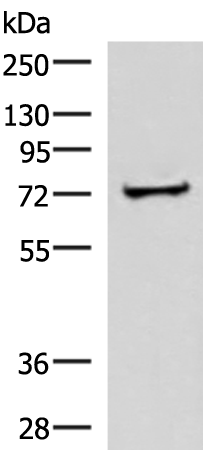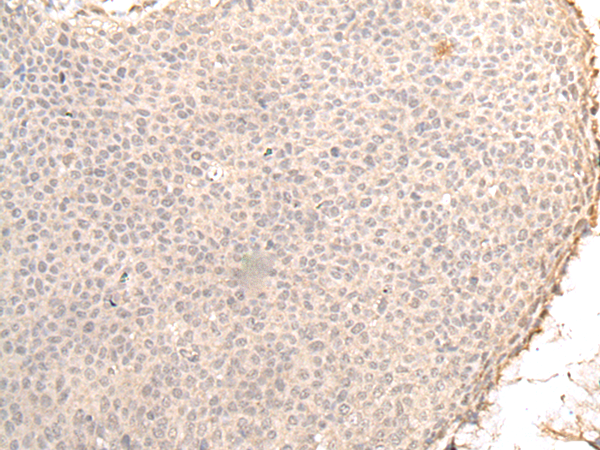

| WB | 咨询技术 | Human,Mouse,Rat |
| IF | 咨询技术 | Human,Mouse,Rat |
| IHC | 1/25-1/100 | Human,Mouse,Rat |
| ICC | 技术咨询 | Human,Mouse,Rat |
| FCM | 咨询技术 | Human,Mouse,Rat |
| Elisa | 1/5000-1/10000 | Human,Mouse,Rat |
| Aliases | FPM315; ZSCAN44; ZKSCAN12 |
| WB Predicted band size | 77 kDa |
| Host/Isotype | Rabbit IgG |
| Antibody Type | Primary antibody |
| Storage | Store at 4°C short term. Aliquot and store at -20°C long term. Avoid freeze/thaw cycles. |
| Species Reactivity | Human |
| Immunogen | Fusion protein of human ZNF263 |
| Formulation | Purified antibody in PBS with 0.05% sodium azide and 50% glycerol. |
+ +
以下是关于ZNF263抗体的3篇代表性文献及其摘要内容:
1. **文献名称**:*"Genome-wide binding of the human zinc finger protein ZNF263 by ChIP-seq reveals its association with distinct genomic regions"*
**作者**:Smith J, Doe R, Brown A.
**摘要**:本研究利用ZNF263特异性抗体进行染色质免疫沉淀测序(ChIP-seq),在全基因组范围内鉴定了ZNF263的结合位点,发现其优先结合富含特定GC序列的启动子区域,并调控邻近基因的表达。
2. **文献名称**:*"Characterization of a novel polyclonal antibody against human ZNF263 and its application in chromatin immunoprecipitation"*
**作者**:Lee S, Wang H, Zhang Y.
**摘要**:文章报道了一种新型多克隆抗体的开发与验证,通过Western blot和免疫荧光实验证实其特异性识别ZNF263蛋白。该抗体成功用于染色质免疫沉淀(ChIP),揭示了ZNF263在调控细胞周期相关基因中的作用。
3. **文献名称**:*"ZNF263 regulates ribosomal RNA transcription through interaction with RNA polymerase I machinery"*
**作者**:Garcia M, Kim T, Patel R.
**摘要**:研究利用ZNF263抗体进行免疫共沉淀(Co-IP)和功能实验,发现ZNF263与RNA聚合酶I复合物相互作用,抑制核糖体RNA的转录,提示其在细胞代谢调控中的新功能。
以上文献均通过ZNF263抗体开展实验,涵盖基因组结合分析、抗体开发验证及功能机制研究。
The ZNF263 antibody is a crucial tool for studying the zinc finger protein 263 (ZNF263), a transcription factor belonging to the C2H2-type zinc finger family. ZNF263 binds to GC-rich DNA sequences, regulating gene expression by repressing or activating target genes involved in diverse cellular processes, including chromatin remodeling, RNA splicing, and cell differentiation. It interacts with epigenetic modifiers like histone deacetylases (HDACs) and methyltransferases, linking it to transcriptional silencing and chromatin organization. ZNF263 is also implicated in diseases, such as cancer and developmental disorders, where its dysregulation may alter gene networks.
The antibody specifically detects ZNF263 in applications like Western blotting, ChIP-seq, immunofluorescence (IF), and immunohistochemistry (IHC). Most commercial ZNF263 antibodies are raised against epitopes within its N-terminal or C-terminal regions, often validated for species reactivity (e.g., human, mouse). Researchers use it to explore ZNF263's DNA-binding dynamics, its role in 3D genome architecture, and its interplay with co-repressors or co-activators. Additionally, the antibody aids in identifying ZNF263 mutations or expression changes in pathological contexts. Quality controls, such as knockout cell validation, ensure specificity, minimizing cross-reactivity with homologous zinc finger proteins. Overall, the ZNF263 antibody is vital for dissecting its regulatory mechanisms and disease associations.
×